Growing avocado from seed is fun and easy, and you can use the pit from your grocery store fruit.
In this post, I will give you detailed instructions for how to grow an avocado seed in just 5 simple steps.
You’ll also learn the best method to use (water or soil), when to start, how to pot up and care for the seedling, and get tons of tips along the way for the best success.
Overview Of Growing Avocado From Seed
| Germination time: | 6-8 weeks |
| When to start: | Late winter through spring are the best times |
| Easiest method: | Sprouting the seed in water |
| Sun exposure: | Indirect bright light during germination |
| Planting depth: | Suspend the pit so the bottom ½ is submerged |
| Temperature: | 70-80°F |
How Long Does It Take To Grow From Seed?
It takes about 6-8 weeks to grow an avocado from seed. Sometimes it can be faster, depending on the environment. To try speeding up the germination time, put it in a warm location.
The time it takes from seed to harvest is much longer. It can take 10-15 years for them to become mature enough to set fruit …that is, if they ever produce anything.
Many times, an avocado plant grown from seed will not produce fruit – and if it does, it will be different than what you buy at the store. So most people just keep them as houseplants or ornamental trees in the garden.
Related Post: How To Care For An Avocado Tree
Tips For Planting An Avocado Seed
Before you go planting your avocado seed, it’s important to plan ahead so you get it right the first time. Below I’ll talk about the different methods you can use, how to harvest and prepare the pit, and when to start.
Planting Methods
There are two methods you could try for growing your avocado seed: planting it in soil, or sprouting the pit in water.
- Planting in soil – You can plant the pit in soil just like any other type of seed. But this method is more difficult, because they are fussy about the moisture level, and it can be hard to get it just right.
- Starting them in water – It’s easier and much more fun to start them in water, and you can watch the roots sprout. So this is the method I’ll focus on in this guide.
When To Plant An Avocado Seed
The best time to start them is in late winter or early spring, when the sun is getting stronger and the weather starts warming up.
But you can plant an avocado seed at any time of the year. Just keep in mind that it may take longer to germinate during the cooler fall and winter months.
Preparing The Pit For Planting
To make sure you have the best success, here are a few things you should do to prepare the avocado seed before you plant it:
- Be sure that you take the pit from a ripe avocado. The riper the fruit, the more mature the seed will be. An immature one probably won’t germinate.
- Gently remove the pit with a spoon rather than a knife, and try not to damage or cut it in the process.
- Wash the seed in warm water, rubbing it gently to clean off all of the bits of flesh, otherwise it could mold.
- Make sure you know which side is up – the bottom is the end that goes into the water. Some pits have a distinct point on top, while others are more rounded. Either way, the bottom is a bit flatter, and has a circular spot where the roots will come out.
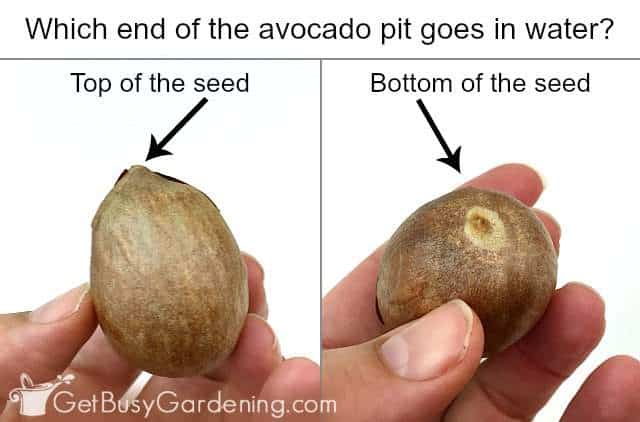
How To Grow An Avocado Seed In Water
You only need a few things to get started, and growing avocado from seed in water is pretty easy. The steps are the same no matter if you have a Hass, or some other variety.
The biggest thing to remember is that it can take as long as 6-8 weeks for the roots or stem to break through the pit, so you have to be patient.
Supplies Needed:
- Clean avocado pit
- 3 toothpicks (or try this fun gadget)
- 1 clear vase or jar*
- Tepid water
* Your container does not have to be clear – but it’s way more fun if it is because you can watch the roots grow.
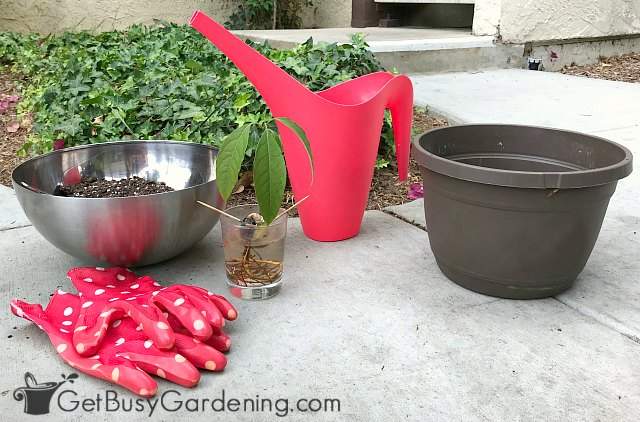
Step By Step Instructions
Step 1: Stick toothpicks into the pit – Take three toothpicks and stick them into the pit, equidistant from one another. You’ll need to push firmly, but it isn’t difficult to insert them.
Alternatively, you could use a growing kit that it specifically designed for this purpose, and then you won’t need the toothpicks.
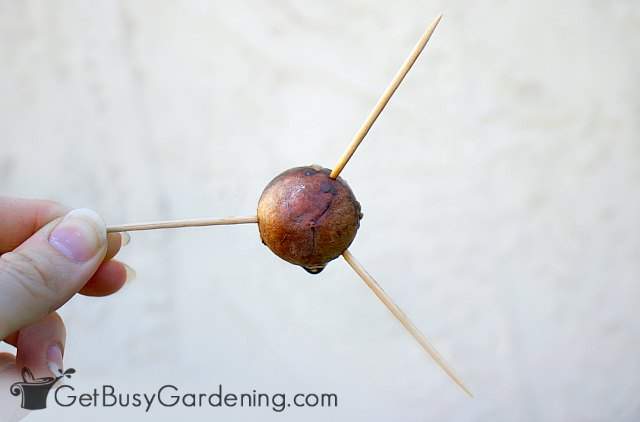
Step 2: Suspend the seed in water – Fill your vase or jar with water, then gently set the pit on top with the toothpicks resting on the rim of the container. Make sure that only the bottom 1/2 of the seed is submerged, and the top stays dry.
Step 3: Put it in a bright, warm location – Place the vase in a warm location where the pit will get bright, indirect light – keep it out of the direct sun at this point. Also, the warmer the temperature is, the faster the seed will sprout, ideally it should be between 70-80°F.

Step 4: Keep the water fresh – While you are watching and waiting to see the roots sprout through the bottom of the pit, the water will get foggy. This is normal, but you should replace it regularly with tepid water so your avocado seed won’t rot or mold.
Also, top it off as it evaporates, so the bottom of the pit remains in the water at all times, and never allow it to dry out completely.
Tip: Around the same time as roots begin to develop, the top of the pit will break open as the stem emerges. So don’t panic when the seed cracks, that means it’s germinating. If this doesn’t happen after 8 weeks, or the seed becomes black and mushy, moldy, or stinky, then discard it and start over with a fresh pit.
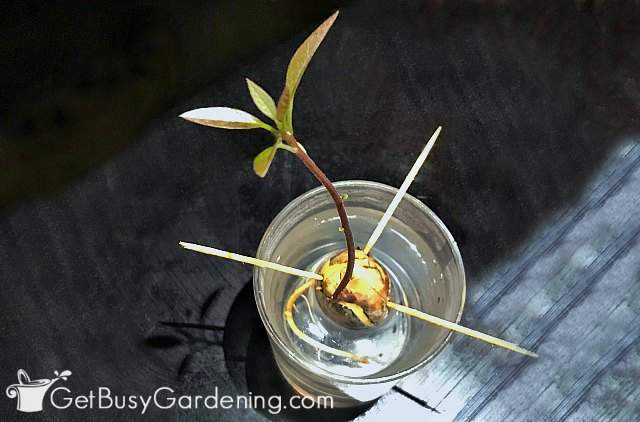
Step 5: Cut the stem back – After the roots (from the bottom of the seed; in the water) and stem (from the top of the pit; upwards) have sprouted, allow your avocado seedling to grow until it reaches 6-7 inches tall. Then cut it down to 3 inches.
While this is scary, and it seems like you’re killing the new plant, it’s actually the best way to encourage a stronger, healthier trunk and root system. Be sure to use a sharp and sterile pair of shears or pruning snips. After cutting it back, keep it in the water until the stem has leaves again.
How To Care For Your Avocado Seedling
When the roots are healthy and thick, and the stem has new leaves, it’s time to plant your avocado seedling in soil. Below I’ll show you how, and give you tips to help ease the transition:
Potting It Up
Use a clean container that’s deep enough for the taproot and has drainage holes in the bottom. As you work to repot your seedling, be very careful because the roots are delicate and can break easily.
You can just use a general purpose potting soil. However, if you tend to overwater, I recommend mixing in some perlite or coarse sand to improve drainage.
Remove the toothpicks and position the seed at the same depth that it was in the water – the pit should stick out at least half way. Fill the pot with soil, making sure to cover all of the roots. Gently pack it in to hold the plant upright, then give it a drink.
Light
When you’re done potting up your avocado seedling, place it in the same area where the vase was. It’s best to give it indirect light at first so it can recover from the shock of being planted in soil.
After a few weeks, you can slowly move it to a full sun location outdoors, or put it in a south facing window inside the house.
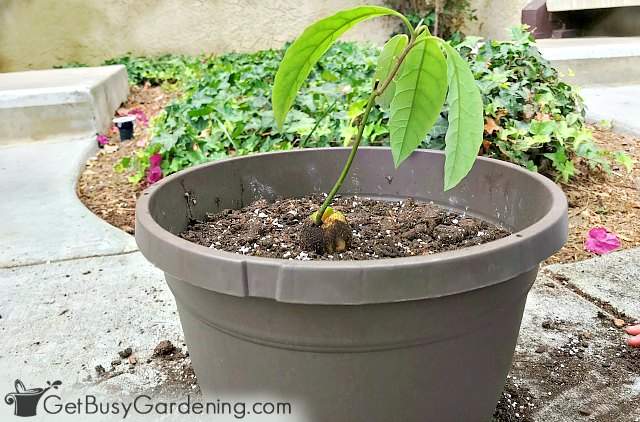
Water
You should water your avocado seedling fairly frequently, especially in the beginning. Keep the soil consistently moist until it’s established in the new container.
Always let the excess water drain completely from the bottom of your pot, the soil should never feel wet or saturated.
Pruning
When it reaches 12” (one foot) tall, cut your seedling back again – this time down to 6 inches. It seems scary to prune it back that much, but this encourages new shoots and branching for a fuller, bushier plant.
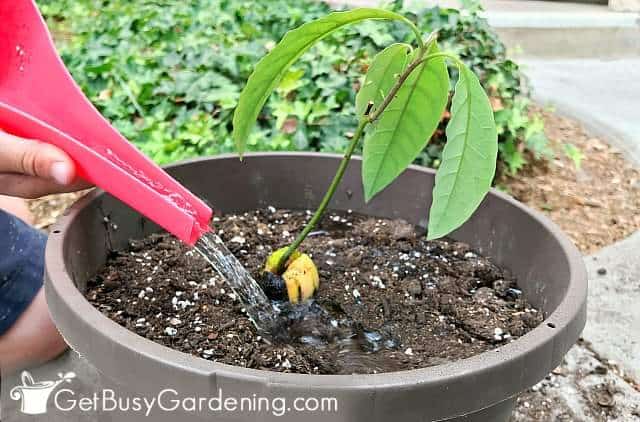
FAQs
No, they do not need light to germinate. But for the best results, you shouldn’t plant them very deep, or the stem might not be able to emerge properly. Over the years, I have found many germinated avocado seeds buried deep in my compost bin (haha!), so I know from experience that they don’t need light to germinate.
There’s no need to dry your avocado seeds first, you can plant them right away. In fact, it’s a good idea to plant the pit as soon as you can after you remove it from the fruit.
If your avocado seed has only been dried out for a few days, it should be fine. But if it dries too much, it might not sprout.
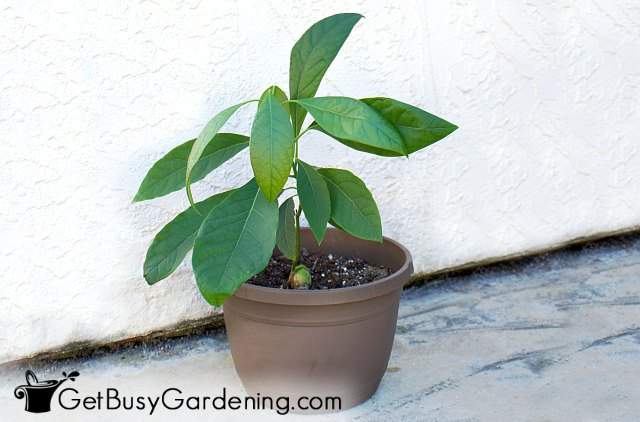
Once it’s established in the new pot, you can keep your avocado as a houseplant, or transplant it outside if you live in a warmer climate. Growing avocado from seed is fun, and it’s so exciting when you see your first root or stem poke through the pit.
If you’re tired of struggling, and want to learn how to grow any plant you want from seed, then enroll in my online Seed Starting Course. It’s a wonderful, fun, self-paced course that will teach you everything you need to know to easily grow your own seedlings. Enroll and get started today!
Or, if you just need a refresher, then my Starting Seeds Indoors eBook is for you! It’s a quick-start guide that will get you planting seeds in no time.
Share your tips for growing avocado from seed in the comments section below.
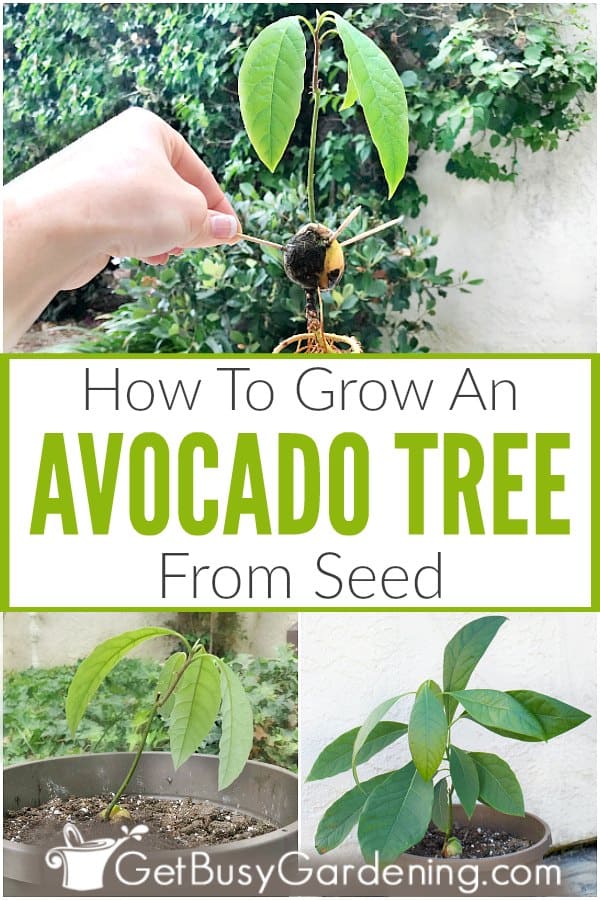

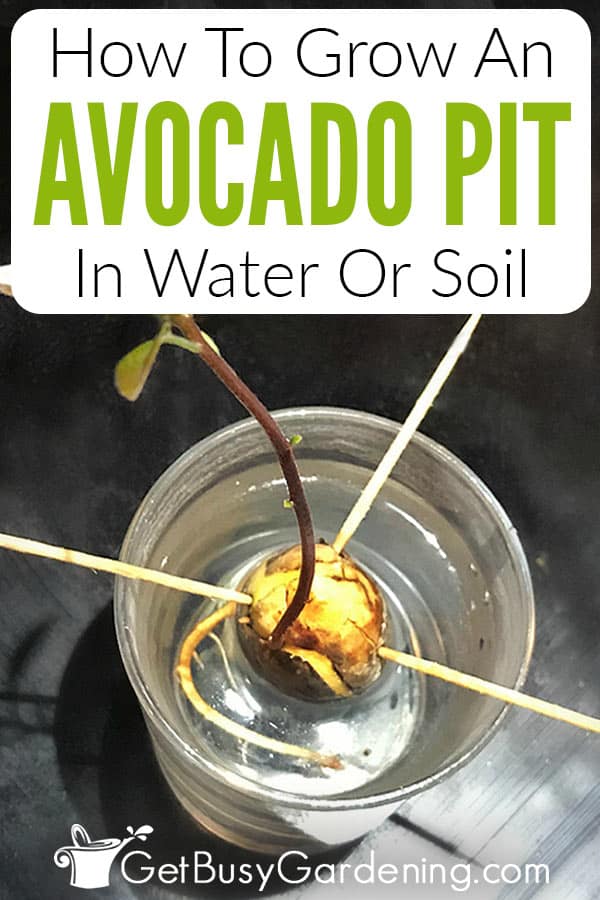
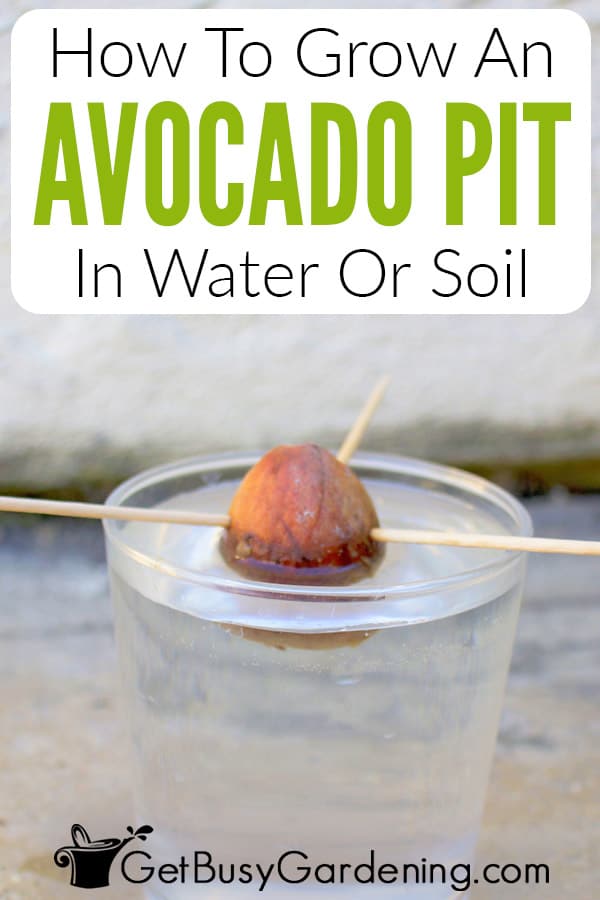
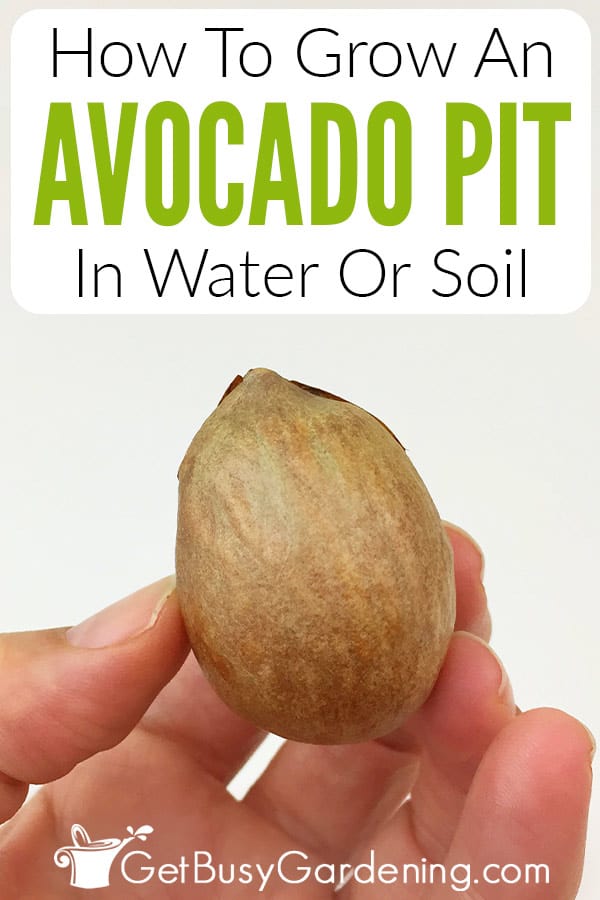
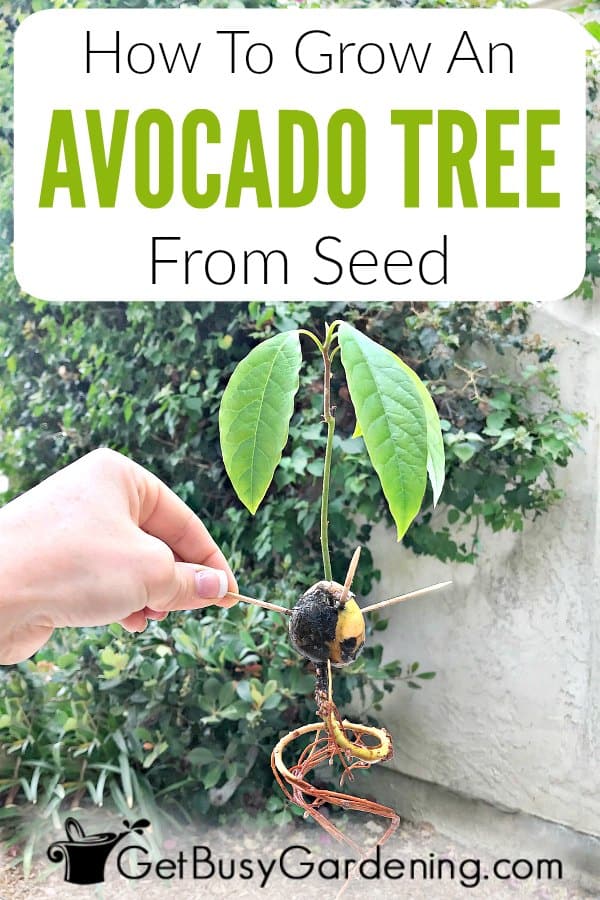
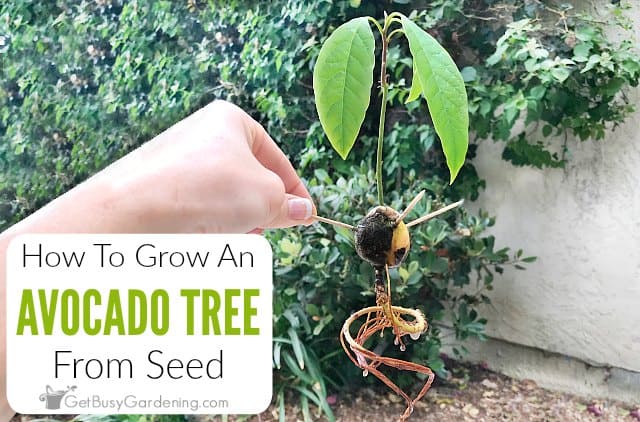



Susie Wilson says
About a month or two ago, I started an avocado pit following directions like yours. The resulting “tree” is now about 17″ from the top of the pit to a cluster of 7 leaves along the top of the stem. Where I cut it is 4″ from the top of the pit. I thought I had cut it to 3″ originally, but I’m guessing the stem has grown all along its length, not just at the top. I have not planted it yet but it does have a healthy root.
My question is – about how tall will this seedling ultimately get? Will pruning it periodically keep it to a height that will not overwhelm a room? I plan to keep it inside except for some limited time outdoors in the summer. Is there a proper way to trim it? Will cutting the stem back to 3 or 4″ again help keep it a manageable size or will it kill it? If you do recommend cutting it again, when should I plant it? Thank you.
Amy Andrychowicz says
Awesome, congrats on your success! I would pot your avocado seedling up now and give it time to become established in the container before you prune it again. Once it’s used to growing in soil, then you can prune it as necessary to maintain the shape and size you desire.
Michelle Norman says
Hi. I planted an avocado pit in water about 4 months ago and the root still hasn’t sprouted, but the pit has cracked. I noticed about 3 weeks ago that the pit was turning red, seeming like it was sunburned. I went to check on it today and the water was all foggy and orange, and the pit was black and a little moldy. Do you think the pit is dead? Or is this part of the decaying process?
Amy Andrychowicz says
The fact that the pit is turning colors, getting molding, and the water is foggy tells me that your avocado seed is rotting. It will never grow, so all you can do at this point is discard it and try again with a fresh new pit.
Debra S George says
I put an avocado pit in the same pot as I had a lilac tree growing. This spring it pop up. It was à suprise it had been outside all through the winter months and we did have some real cold weather. I live in Central Texas I have just repotted it in a bigger pot by itself. Do I need to bring it in or will it be ok outside. It’s about 12 inches high now.
Amy Andrychowicz says
Avocado trees are typically hardy down to zone 9, so whether you can leave them outdoors all winter depends on your growing zone.
Tricia says
I just stumbled on this site and what I thought was a nice avocado plant might not be. I didn’t know it was to be cut/pruned. My plant is about 2 feet high with leaves at the top and some starting throughout but the steam is very thin. Should I cut it?
Amy Andrychowicz says
Yes, late winter or early spring is a great time to prune it, this will help to encourage bushier growth and a stronger, thicker stem. If your baby avocado plant is full and healthy, then you can just prune it for shape if you want.
Julie says
Hi! I’m growing my avocado plant… just made the scary first cut, after the plant reached the 6”…. I was wondering how long it takes to regrow?
Amy Andrychowicz says
It depends on the environment it’s in, but you should start to see new growth on your avocado seedling in a few weeks or so.
Gary King says
After starting several Avacado seeds using the water method I have grown “stalky” plants that require trimming back, I have a 5 inch tall plant that is full of thick leaves that are curled up and seem to be uncurling with time. I also have a seed that is sprouting 2 stalks. Have you seen either of these happening??? I would send pics if provided an email address. Thanks.
Amy Andrychowicz says
Once your avocado seedlings reach 6″ tall, then you should cut them back by half to encourage it to branch out and become bushier. See the section above titled “Caring For Your Avocado Seedling Growing In Water” for more details about how to do that. You can always post photos on my Facebook page.
Wendy says
Hi Amy ! I am sprouting avocado seeds and they have done so with my wrapping them in damp paper towels and putting them in a ziplock in a sunny window. The largest sprout has a baby stem but no roots. I’ve previously attempted the toothpick suspension method and have no luck. Not sure if I should try toothpick suspension method with the ones that are sprouting in an attempt to get them to root . I’d appreciate any suggestions please and thank you.
Amy Andrychowicz says
I’ve never tried sprouting avocado pits in a plastic baggie before, so I can’t speak from experience. If I were you, I would try suspending them over water to see if they will grow some roots. It certainly doesn’t hurt to try, and sounds like a fun experiment!
Raymond Cheah says
Hi,
I have 2 Avocado seedling still growing in water. They are now 20 inches tall with few small new leaves just grew few days ago. There are quite some roots as well. I did not prune them when they are 7 inches tall as the article suggests. Should I just let them grow since they look healthy or you would suggest to prune them?
Thanks
Amy Andrychowicz says
I would prune it back as I mentioned in the article. Avocado seedlings tend to get a bit tall and lanky if you skip this step. Pruning it back will result in a fuller, more robust tree. But, if you’re happy with the way it’s growing, then you could certainly just leave it be. 🙂
Nazli says
Hi,
Thank you for your help!
My Avocado seed grow from roots very long but on the top of just small Sprouts. Is it okay to put my seed on the put.
Thank you
Nazli
Amy Andrychowicz says
I would wait until the top of the your avocado seedling is at least a few inches tall, and has a few leaves before potting it up.
Jessica Smith says
Hi I have a year old avacado tree thats potted in soil with the seed half exposed. I was wondering what happens to the actual pit of the tree? I’ve noticed it has started to change color now that its outside in part sun, somewhat orangey. Will the pit eventually “disintegrate” into the soil or should it be removed? Is the tree using the pit for nutrients? Thank you
Amy Andrychowicz says
Great question. As your avocado tree matures, the pit will eventually turn yellow, and usually eventually falls off on its own. Don’t remove it unless it comes off very easily, as forcing it could break the roots or stem of the plant. Sounds like yours is starting to die back already, it can take some time.
Jessica Smith says
Thank you so much! I had scoured the internet for quite some time looking for advice on this until finding your site, and I signed up. Much appreciated and Happy gardening to all!
Amy Andrychowicz says
You’re welcome! 🙂 Thanks for signing up, and happy gardening too you too!
Kim says
My avocado pit cracked along the bottom. I can see the stem. But isn’t it growing upside down, the pit should have cracked on top? Do I just leave it the way its growing or turn it upside down?
Thank you.
Amy Andrychowicz says
If you planted the avocado pit with the pointy side facing up, then leave it as is. If the flat end is pointing up, then yes, you should flip it over so that the stem is on top. The roots will grow from the flat end of the avocado pit.
Cathy Hula says
My avocado tree is 3 years old, about 4 ft tall, it has plenty of leaves but the trunk is very thin and needs to be stacked. How can I make it stronger?
Amy Andrychowicz says
It sounds like your avocado tree may not be getting enough light. I would move it to a sunnier location, or add a grow light.
Brianna says
Using your method, will an avocado plant survive solely planted and kept indoors? I live n Ontario Canada so I would only have a few months where it could be left outside in a pot.
Amy Andrychowicz says
Yes, you can grow an avocado plant indoors as a houseplant.
Ioana says
Hi! I tried to grow an avocado tree for like a month now and the roots didn’t grow yet but the stem did. Did I do something wrong or is it normal this way?
Amy Andrychowicz says
As long as the leaves on your avocado seedling look healthy, then I wouldn’t worry. They can be very slow to grow, so give it more time to sprout roots.
Areellia says
Why won’t it grow avocados? I want to grow an avocado tree to enjoy home-grown avocados! If it don’t grow fruit, where can I get an avocado tree that does?
Amy Andrychowicz says
It certainly is possible for a seed-grown avocado tree to bear fruit, but it can take a very long time (like 10+ years). Plus, there’s no guarantee what the fruit will be like (it could be very different than your store-bought avocados). So, it’s said that avocado seedlings need to be grafted onto a mature rootstock in order to bear better fruit faster. So, if you want fruit, then it’s best to buy a grafted tree from a reputable nursery. However, if you live in a cold climate like I do, then you may not have much luck finding them locally, and you’ll likely have to order one online.
Dori says
I have 2 Avocado Trees I planted from seeds or put myself. One is 6’ tall & the other is 3’.
I don’t expect them to produce fruit but also don’t want to lose them to frost or a freeze.
I live in Central Florida but we occasionally have cold weather. What is the best way to protect them?
Amy Andrychowicz says
Avocado trees are hardy down to zone 9. They don’t like the cold, but can handle some frost, and short-term freezing temps. You could try covering your trees with a lightweight cloth (not plastic!!) during freezing temps if it’s feasible. Potted avocado trees can be moved indoors during cold spells.